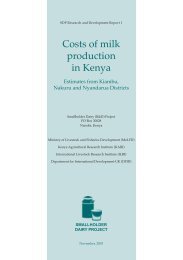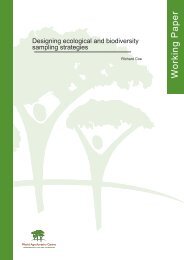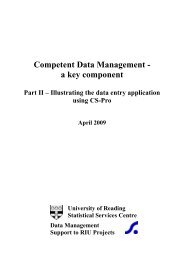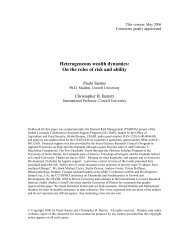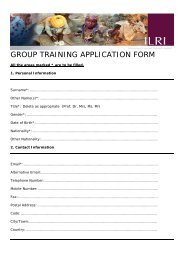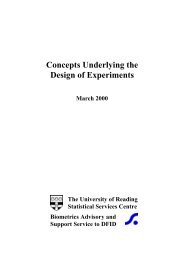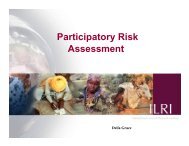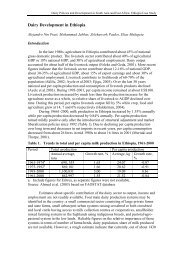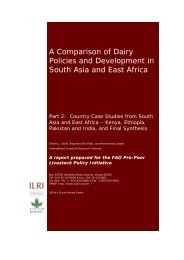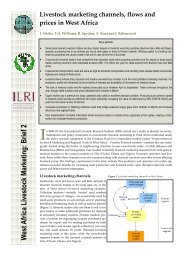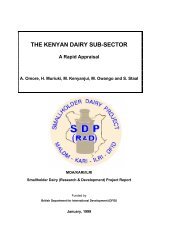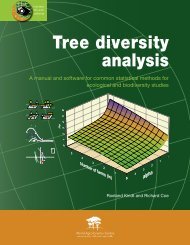Goats outnumber sheep and are found ma<strong>in</strong>ly <strong>in</strong> the ra<strong>in</strong>fed lowlands and uplands <strong>of</strong> central Myanmar,where they are valued as a source <strong>of</strong> <strong>in</strong>come and for meat. The <strong>in</strong>digenous goats have also been <strong>in</strong>fluencedby imports <strong>of</strong> Indian breeds, ma<strong>in</strong>ly the Jamnapari from northern India. The goats are mostly sold bymiddlemen to meet the demand for goat meat <strong>in</strong> the cities <strong>of</strong> Yangon and Mandalay. Sheep are found <strong>in</strong> theupland areas <strong>of</strong> northern Myanmar. The Corriedale breed was <strong>in</strong>troduced from Australia for cross<strong>in</strong>g withthe <strong>in</strong>digenous sheep, but with little success.Pig and poultry production is based on exotic breeds such as the large white, landrace and Berkshire(pigs); and the Rhode Island red and white leghorn (chicken). For fatten<strong>in</strong>g, the large white and Berkshirecrosses are favoured by farmers and animals are slaughtered at about 100 kg liveweight.The diverse animal resources have not been characterised adequately <strong>in</strong> genetic terms and, as aconsequence, the productive potential <strong>of</strong> <strong>in</strong>dividual breeds rema<strong>in</strong>s largely unknown. This is an area that isfundamental to animal improvement <strong>in</strong> Myanmar.<strong>Animal</strong> production systemsRum<strong>in</strong>ants are managed ma<strong>in</strong>ly <strong>in</strong> extensive systems. The only exception to this is dairy production on statefarms, where stall feed<strong>in</strong>g <strong>of</strong> improved grasses and concentrates is practised. Pig and poultry production systemsare <strong>in</strong>tensive state-farm operations, ma<strong>in</strong>ly <strong>in</strong> the peri-urban areas. These commercial units are large and arebased on imported breeds, concentrate feeds and disease control. The state farms have the objectives <strong>of</strong> supply<strong>in</strong>gweaners to farmers for breed<strong>in</strong>g purposes and produc<strong>in</strong>g animals for pork. Manure is a valuable output fromanimal production and is used by farmers for fertilis<strong>in</strong>g crops. Poultry litter is also used for aquaculture.Feed resourcesNative grasses and crop residues form the ma<strong>in</strong> roughage sources for rum<strong>in</strong>ants. On state farms, Brachiariaspp are commonly grown, but <strong>in</strong>adequate use is be<strong>in</strong>g made <strong>of</strong> other more productive species such as Napierand Gu<strong>in</strong>ea grass. Little use is made currently <strong>of</strong> herbaceous legumes or multipurpose trees.The most important crop residues for rum<strong>in</strong>ants are rice straw, maize stover and mungbean stover. Inaddition, several important prote<strong>in</strong> sources are produced such as sesame cake, peanut meal, coconut cake,cottonseed cake and rice bran. The latter is used for all species, <strong>in</strong>clud<strong>in</strong>g fish, and is the ma<strong>in</strong> prote<strong>in</strong> sourcefor pigs, poultry and dairy cattle. Broken rice is also important and is used for both rum<strong>in</strong>ants andnon-rum<strong>in</strong>ants.There are five feed mills <strong>in</strong> the country which produce concentrate feeds for pigs, poultry and dairycattle. However, all these mills are produc<strong>in</strong>g at 50% below capacity, and no clear quality-control measuresexist to protect the purchaser.<strong>Animal</strong> health and diseases<strong>Animal</strong> diseases are not considered to be the major constra<strong>in</strong>t to production. Foot-and-mouth disease andhaemorrhagic septicaemia are the most important diseases <strong>in</strong> large rum<strong>in</strong>ants. Anthrax also occurs <strong>in</strong> cattle.The need for more vacc<strong>in</strong>es for foot-and-mouth disease and haemorrhagic septicaemia was emphasised.Disease-free zones <strong>in</strong> the western part <strong>of</strong> the country are be<strong>in</strong>g contemplated. R<strong>in</strong>derpest was reported last<strong>in</strong> 1957. Chicken are regularly vacc<strong>in</strong>ated aga<strong>in</strong>st Newcastle disease.There is limited research on Gumboro, microplasmosis and <strong>in</strong>fectious bronchitis <strong>in</strong> poultry, andtransmissible enteritis <strong>in</strong> pigs. It was <strong>in</strong>terest<strong>in</strong>g to note that an effective live vacc<strong>in</strong>e for haemorrhagicsepticaemia has been developed locally as a nasal spray. Tests have <strong>in</strong>dicated clearly that the nasal route isa more effective pathway than the systemic one and, more importantly, its effectiveness can last for up to oneyear compared to six months for the latter. In addition, vacc<strong>in</strong>es are produced for redwater, anthrax andfoot-and-mouth disease <strong>in</strong> cattle and buffaloes, sw<strong>in</strong>e fever <strong>in</strong> pigs, anthrax <strong>in</strong> goats and sheep, and Newcastledisease, fowl pox and Gumboro <strong>in</strong> poultry.
Constra<strong>in</strong>ts and opportunitiesInadequate animal numbersThis constra<strong>in</strong>t applies more to rum<strong>in</strong>ants than to non-rum<strong>in</strong>ants, and numbers must be <strong>in</strong>creased if productiontargets are to be atta<strong>in</strong>ed. Increased numbers <strong>of</strong> large rum<strong>in</strong>ants are essential for draft power, as only about5000 tractors are available for land cultivation.Feed resourcesFeeds are an <strong>in</strong>creas<strong>in</strong>g problem for dairy and non-rum<strong>in</strong>ant production. Major programmes are needed toprovide for <strong>in</strong>creased feed supplies <strong>of</strong> high quality to match the needs <strong>of</strong> the expand<strong>in</strong>g animal sub-sector.Poor <strong>in</strong>frastructureSeveral <strong>of</strong> the exist<strong>in</strong>g facilities (laboratories, feed mills and state farms) were orig<strong>in</strong>ally established throughmulti-donor assistance <strong>in</strong> the late 1970s, and now need improvement and upgrad<strong>in</strong>g to support the <strong>in</strong>creased<strong>in</strong>terest <strong>in</strong> animal production. M<strong>in</strong>isterial sources estimate that the cost <strong>of</strong> this upgrad<strong>in</strong>g will be US$ 100,000,which seems rather low given the extent <strong>of</strong> the facilities available and the improvements necessary.Research capacityStrengthen<strong>in</strong>g <strong>of</strong> <strong>in</strong>stitutional capacity <strong>in</strong> research management, research methodology development, farm<strong>in</strong>gsystems research and natural resource management are priority issues. The country, for political reasons, hasbeen isolated <strong>in</strong> recent years. However, Myanmar has done well <strong>in</strong> organis<strong>in</strong>g the shift from a centrallyplanned economy to that <strong>of</strong> the open market with m<strong>in</strong>imal external support, although socio-economic andpolicy issues related to animals have hardly been addressed. In these circumstances, the country will needmore exposure and contact with its neighbours <strong>in</strong> the region to address common problems as well as solicit<strong>in</strong>gexternal support for develop<strong>in</strong>g research capacity. Associated with this will be the need to improve access to<strong>in</strong>formation sources. Presently, scientists have virtually no access to new books or <strong>in</strong>ternational journalsunless they leave the country for postgraduate study or meet<strong>in</strong>gs.The Philipp<strong>in</strong>esEnvironment and cropp<strong>in</strong>g systemsThe climate <strong>in</strong> the Philipp<strong>in</strong>es is generally favourable for crop growth. Only <strong>in</strong> the north is there a pronounceddry season. The areas <strong>of</strong> cultivation total nearly 22 million ha (Faylon and Roxas 1995). Although rice, maize,root crops and sugar-cane are the ma<strong>in</strong> crops grown throughout the archipelago, a wide range <strong>of</strong> secondarycrops, e.g. p<strong>in</strong>eapple, fruit (mango, citrus and jackfruit) and vegetables is grown <strong>in</strong> different regions. Bothmonoculture and <strong>in</strong>tensive multiple-cropp<strong>in</strong>g patterns are evident. The latter <strong>in</strong>clude <strong>in</strong>ter-cropp<strong>in</strong>g andsequential-cropp<strong>in</strong>g systems, with annual crops also <strong>in</strong>tegrated <strong>in</strong>to plantation agriculture. The Philipp<strong>in</strong>eshas the largest coconut area <strong>in</strong> the world (approximately 3.2 million ha), with the greatest concentrations <strong>in</strong>the M<strong>in</strong>danao island group. Some 91% <strong>of</strong> coconut hold<strong>in</strong>gs are farms <strong>of</strong>
- Page 2 and 3:
Affiliation of Authors:Dr C. Devend
- Page 4 and 5:
6.Strategyfor researchJustification
- Page 7 and 8:
AcknowledgementsThe International L
- Page 9 and 10:
esearch opportunities appropriate t
- Page 11 and 12:
Table 1.Animal populations and meat
- Page 13 and 14:
Introduction2. Characterisation and
- Page 15 and 16:
Figure 2. Sub-humid tropics and sub
- Page 17 and 18:
Table 3.Human and animal population
- Page 19 and 20:
Table 5. Rice-growing environments
- Page 21 and 22:
Multiple upland annual crop systems
- Page 23 and 24:
Table 6. Continued.Country Importan
- Page 25 and 26:
It should be noted that, compared w
- Page 27 and 28:
Table 8.CountryCambodiaChinaIndones
- Page 29 and 30: of non-renewable fossil fuels and t
- Page 31 and 32: Overview of researchThere was a sur
- Page 33 and 34: • Identification of alternative c
- Page 35 and 36: Various animal production systems t
- Page 37 and 38: Presently, much of the vegetable pr
- Page 39 and 40: Table 10. Summary of the main socio
- Page 41 and 42: Table 11. Institutions and organisa
- Page 43 and 44: 3. In the ASEAN sub-region, inadequ
- Page 45 and 46: Table 12. Continued.SituationsPract
- Page 47 and 48: 6. Strategy for researchJustificati
- Page 49 and 50: Table 13. Priorities for research a
- Page 51 and 52: VietnamResearch capacity in NARS is
- Page 53 and 54: CRIFC (Central Research Institute f
- Page 55 and 56: IAS. 1995. Proceedings of the Works
- Page 57 and 58: Systems of sub-Saharan Africa. Volu
- Page 59 and 60: or waterlogged in the wet season an
- Page 61 and 62: Table A1. Important diseases of ani
- Page 63 and 64: • Increased cropping intensities,
- Page 65 and 66: the animal output came from pigs al
- Page 67 and 68: 18-21° North, with an average rain
- Page 69 and 70: In the Nusa Tenggara islands, signi
- Page 71 and 72: Women work 11.5 h/day on average co
- Page 73 and 74: Various Australian forage projects
- Page 75 and 76: village production systems; to stud
- Page 77 and 78: The availability of feed in rubber
- Page 79: of the Ayeyarwady and Sittang river
- Page 83 and 84: gaining in importance, and signific
- Page 85 and 86: Table A3. Characterisation of crop-
- Page 87 and 88: Table A4. Interventions in crop-ani
- Page 89 and 90: Table A4. Continued.Project TitleGo
- Page 91 and 92: otations are practised, and there a
- Page 93 and 94: such as abortion. Vaccination cover
- Page 95 and 96: large areas of forests (3.4 million
- Page 97 and 98: Table A6. Some animal diseases repo
- Page 99 and 100: Appendix IIItineraryThe Philippines
- Page 101 and 102: 26 November 1996 am Visit to small
- Page 103 and 104: Appendix IIIList of persons metPhil
- Page 105 and 106: Mr Chhiv Nan, Acting Director, Depa
- Page 107 and 108: Dr U Maung Ngint, Managing Director
- Page 109: List of acronymsAARDACIARADBAEZAIBP



